To say its been a busy few weeks is a massive understatement. You may have noticed I’ve been on the quite side, so thought it might be a good time to bring you all up to date.

Trip diary’s, plans and general travel stuff from me

To say its been a busy few weeks is a massive understatement. You may have noticed I’ve been on the quite side, so thought it might be a good time to bring you all up to date.
Don Carlos is an eccentric, and an innovator and an experimenter. He doesn’t follow the rules he makes them–listen to our chat as we walked around the farm earlier this year.
From this January’s trip, one of the highlights for me was to meet up with Don Carlos from Finca la Pira in Tarrazu, Costa Rica.
You see Don Carlos is an eccentric, and an innovator and an experimenter. He doesn’t follow the rules he makes them.
The walk around was lots of fun, and I recorded our conversations, so you can share a little of the trip here.
You can also see the Flickr pictures here
Some things have changed since we first opened our doors, but my thoughts on sourcing travel and relationships haven’t really.
The most common question I ever get when meeting someone for the first time is “Why do you travel so much?” I hate flying, it’s been a phobia I’ve had for many years, and I am a terrible road passenger moaning and groaning. I rarely cup when I’m at origin, as the differing protocols, different water, and your body clock and diet all messed up means you can not do a good job at the cupping table. Coffee often tastes better when you’re in the sun, with friends, having a blast. If it tastes good in Stafford on a rainy Tuesday night, then it will taste good anywhere.
And lots of coffee roasters buy their coffee without ever setting foot on an airplane. So why do I put myself through the torture of traveling to origin? 2016 brought 129 flights all over the world and many many air miles, with 2017 not looking a lot better with 13 already in the middle of February.
Well it’s not for the airline food or my love of airports. We buy directly from over 50 farms and over 20 different producers in 9 different countries. Add to this the relationships we have with importers who still need love and attention to make sure the great coffee keeps flowing, and we continue to work together.
The advent of the internet has made this much easier to manage these long distance relationships and much of my day is spent firing emails and whats apps backwards and forwards. But for those of us that have had long distance relationships, this doesn’t work for all the details. Seeing the whites of the eyes of the person you’re dealing with fixes many of the problems and challenges, and also gets across your points of view, and a chance for you to hear theirs.
Let me give you an example. On my trip a few weeks ago to Central America, I spent the day on a farm we have been buying from for a few years. By now, I’ve been on a lot of farms and have gained knowledge from experienced growers on parameters and processes.
I ask similar questions everywhere I go: “What varietals do you grow?”, “walk me through the way you process the coffee”, “What kind of drying times are you getting?”. The farm in question answered the last question differently to other places I work with, farms all with a similar set of conditions. But the farm in question dried their coffee much quicker than normal.
Now it could be that this is best for this farm and mill, and I’m always very careful to not prescribe to producers what they should do. I use the mantra that if they turned up to my roastery and told me how to roast, I’d be quite annoyed at them, and I think they would feel the same for my advice if delivered wrong. Email and short messages can often be misconstrued this way, even more so when English is often the second language.
But they were super interested in this idea, so within 5 minutes, we were splitting a lot, and using half of it as a control sample doing what they normally do, and the other half slowing down the drying process to see what difference it will make. It could be that few learn nothing apart from what they are doing is amazing, but we could both learn what slowing down that drying process does to the coffee. We are both excited to see the result and how it turns out, both learning, and something that just doesn’t happen on a Skype call, and could be delivered in a way that was “wouldn’t this be interesting” instead of “do this do that”.
Another trip a couple of years ago, I took one of my favourite producers (and one of my closest friends) Alejandro Martinez (or Finca Argentina fame) to Honduras and Nicaragua to learn more about how they do things there. From the visit, he has built new relationships too, with experienced farmers, a resource for some new varietals to try on his farm and someone to bounce ideas off who knows what they are talking about (aka posed to me and my crazy thoughts.). The trip was so successful that when I left for home, Ale stayed with the producers, and learnt a little bit more with them.
Relationships are difficult, not just coffee ones, relationships in general. We all screw up, we all make mistakes. But you know, when you visit someone, all those screw ups and mistakes kind of get forgiven, as you get to understand the person, their challenges, and their strengths and weakness, and you learn to work as a team. But they also learn your weaknesses and you buy yourself so much goodwill.
I make lots of mistakes, I make lots of wrong calls and fly off the handle all the time. Catching up with my mates at origin is not only lots of fun (and it really is) but a chance for them to forgive my mess ups, an important piece of apparatus in my sourcing toolbox.

So Roland sneaked in an extra day before his flights home, so here it is.
I kept up the busy pace for my last day in Costa Rica. Francisco, our exporter, arranged to take a group of jury members out to the West Valley to see some of the farms and mills that had success yesterday. Luckily for me, there were some familiar names in the Cup of Excellence results!
We started with a visit to the Herbazu micromill. Antonio from Herbazu won the top spot, and of course we’ve had coffees from them for quite a few years now, so it was great to see him and the mill. From there, he took us up to the farm plot that had won – Leoncio. Named after his grandfather, it’s a very organised farm. He’s planted it with a range of different varietals – bourbon, geisha, villa sarchi, Ethiopian, Catimor and the one he used for the winning lot – SL28. This is one we think of as a Kenyan varietal, but in this case his seeds came from El Salvador.

This was also a great example of how close speciality coffee growing in Costa Rica – and especially the West Valley – is: Finca Leoncio is the plot of land directly below Cafe ARBAR, that I had visited last Saturday! As we were leaving, we stopped to say hello to Carlos there and he ended up coming with us to our next stop. Only two minutes down the road, we found ourselves at the Vista Al Valle micromill – another familiar name! As it happens, Carlos is also a cousin of the family who own the mill, so soon all of us were in the family’s front room were they’d put on a lovely spread of fresh fruit for everyone.
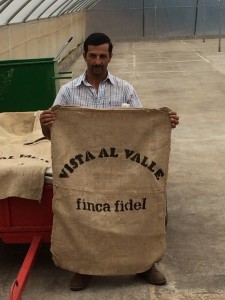 We then took a look around their mill – it really lived up to it’s name – View of the Valley. After spending time looking around, Francisco, ourselves and all the producers and their families went up to a local restaurant for some lunch. It really reinforced the sense of community within the West Valley, as more farmers turned up and everyone chatted over food, with lots of congratulations to Antonio!
We then took a look around their mill – it really lived up to it’s name – View of the Valley. After spending time looking around, Francisco, ourselves and all the producers and their families went up to a local restaurant for some lunch. It really reinforced the sense of community within the West Valley, as more farmers turned up and everyone chatted over food, with lots of congratulations to Antonio!
All that was left was for me to head to the airport and the long journey home. Saying my goodbyes, it felt hard to imagine that I had only met everyone in the last week. Being on a Cup of Excellence jury and meeting producers was an intense experience – absolutely incredible – and one I’ll never forget.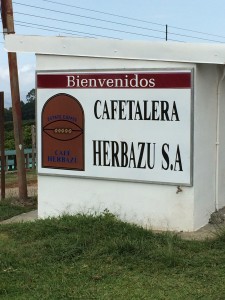
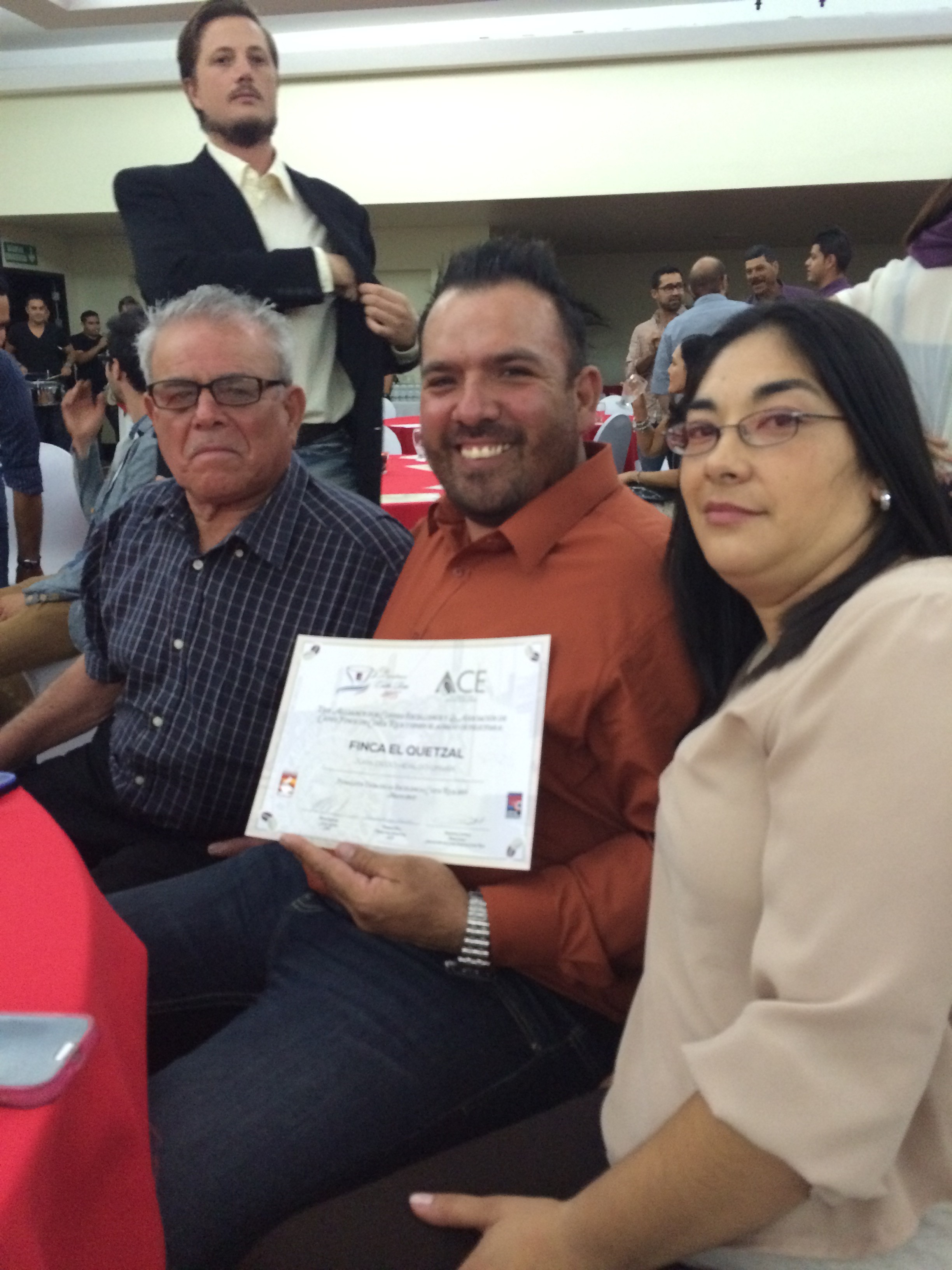
The last day of Cup of Excellence Costa Rica 2015 started as early as the others, but this time we only had one cupping session. By this point, we had selected the top 10, so our task for the day was to give them final scores and descriptions for use when they are put up to auction. For this cupping, we were also joined by members of the National Jury and other guests to see what we had picked. It’s a really interesting selection that made it, as they are very varied.
The end of the cupping was a bit of a mixed experience – a relief to have got the last round of cupping finished, but also sadness that it was the end of the week and time to say goodbye to new friends. Everyone who ran the event did a great job and was incredibly helpful and friendly – there’s a lot involved in getting something this big organised and they did fantastically.
Our scores were compiled and the final rankings decided, ready for the awards ceremony in the afternoon. In the end, 35 coffees have made it to auction, with the top two scoring over 90 points and getting a special Presidential Award. The awards ceremony itself was quite an experience too – the atmosphere was electric as they started announcing the winning farms.
I was sat with the family from a farm called El Quetzal, who were competing for the first time in Cup of Excellence. They were placed 35th this time, and we’re really happy to have got CoE status. It was also very positive to hear how committed they were to learning from the experience and to build on their success for next year.

So the diary continues, he hasn’t been taken by bandits or tied up and held hostage, he’s still cupping
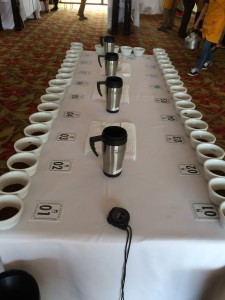 My time in Costa Rica has really flown, with today being my sixth day and also the end of the first round of the Cup of Excellence competition. Very much as Day 5, today we started at 8am and did three rounds of cuppings to score the remaining coffees. Our discussions after scoring are really interesting to see which coffees split opinion, and which we mostly agree on. Before tomorrow, all our scores will be averaged, allowing the round 1 coffees to be cut down to round 2 contenders, which we will cup again.
My time in Costa Rica has really flown, with today being my sixth day and also the end of the first round of the Cup of Excellence competition. Very much as Day 5, today we started at 8am and did three rounds of cuppings to score the remaining coffees. Our discussions after scoring are really interesting to see which coffees split opinion, and which we mostly agree on. Before tomorrow, all our scores will be averaged, allowing the round 1 coffees to be cut down to round 2 contenders, which we will cup again.
After lunch, the International Jury was taken on a trip to a farm and mill near Naranjo called Finca Santa Anita. Not far from Cafe ARBAR, I got to again see the beautiful views of the West Valley.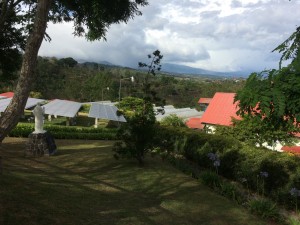
At Santa Anita we met the family who own the mill and farm – the 3rd and 4th generations since the farm was founded. The farm processes about 14,000 46kg sacks of coffee a year, both from themselves and other small farms in the area – quite a bit smaller than Beneficio La Eva that we saw yesterday. A really clean and well organised farm and mill, they’ve also invested in solar panels which provides 85% of the electricity they need to run the mill when it’s busy. In their cupping room, I had a surprise, as their cupping table and sample roaster are the same type we used at Has Bean until recently.